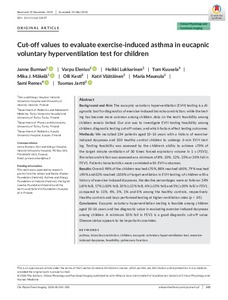Cut-off values to evaluate exercise-induced asthma in eucapnic voluntary hyperventilation test for children
Burman J; Elenius V; Lukkarinen H; Kuusela T; Mäkelä MJ; Kesti O; Väätäinen K; Maunula M; Remes S; Jartti T
Cut-off values to evaluate exercise-induced asthma in eucapnic voluntary hyperventilation test for children
Burman J
Elenius V
Lukkarinen H
Kuusela T
Mäkelä MJ
Kesti O
Väätäinen K
Maunula M
Remes S
Jartti T
WILEY
Julkaisun pysyvä osoite on:
https://urn.fi/URN:NBN:fi-fe2021042826439
https://urn.fi/URN:NBN:fi-fe2021042826439
Tiivistelmä
Background and Aim The eucapnic voluntary hyperventilation (EVH) testing is a diagnostic tool for diagnostics of exercise-induced bronchoconstriction; while the testing has become more common among children, data on the test's feasibility among children remain limited. Our aim was to investigate EVH testing feasibility among children, diagnostic testing cut-off values, and which factors affect testing outcomes. Methods We recruited 134 patients aged 10-16 years with a history of exercise-induced dyspnoea and 100 healthy control children to undergo 6-min EVH testing. Testing feasibility was assessed by the children's ability to achieve >= 70% of the target minute ventilation of 30 times forced expiratory volume in 1 s (FEV1). Bronchoconstriction was assessed as a minimum of 8%, 10%, 12%, 15% or 20% fall in FEV1. Patient characteristics were correlated with EVH outcomes. Results Overall, 98% of the children reached >= 70%, 88% reached >= 80%, 79% reached >= 90% and 62% reached >= 100% of target ventilation in EVH testing; of children with a history of exercise-induced dyspnoea, the decline percentages were as follows: 24% (>= 8% fall), 17% (>= 10% fall), 10% (>= 12% fall), 6% (>= 15% fall) and 5% (>= 20% fall) in FEV1, compared to 11%, 4%, 3%, 1% and 0% among the healthy controls, respectively. Healthy controls and boys performed testing at higher ventilation rates (p < .05). Conclusion Eucapnic voluntary hyperventilation testing is feasible among children aged 10-16 years and has diagnostic value in evaluating exercise-induced dyspnoea among children. A minimum 10% fall in FEV1 is a good diagnostic cut-off value. Disease status appears to be important covariates.
Kokoelmat
- Rinnakkaistallenteet [27094]
